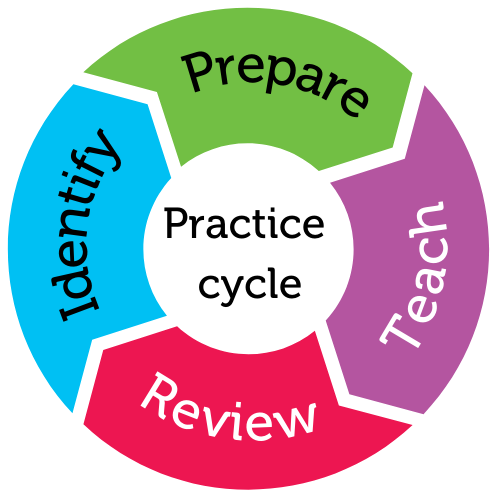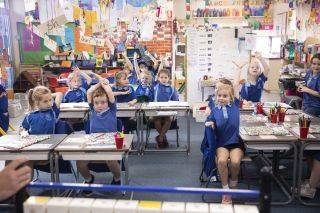
For student year
Helps students to
- know what is expected
- understand consequences
Helps teachers to
- set classroom expectations
- respond to behaviour
Summary
For the primary school version of this practice, go to:
Establish classroom expectations (Foundation to year 6)
Some students, including those on the autism spectrum, may not understand the unspoken social and behavioural expectations of your classroom. Establishing and clearly communicating these up front helps students know what’s expected of them.
Stating classroom expectations is especially important for year 7 students who are new to secondary school learning environments and who likely come from a variety of primary schools — each with its own set of expectations.
Also, because secondary students migrate between rooms for different subjects, it’s important to point out that expectations may differ depending on the room and subject. For instance, science labs and food technology classrooms contain potentially harmful equipment that require specific health and safety considerations. It’s important your students are aware of the unique expectations of each learning environment they enter.
When students understand what’s expected of them, the classroom becomes a more productive working environment. This practice will explain how to establish and reinforce class expectations to support all students to understand what’s required when learning and interacting with others at school.
“Explain and discuss the rules with students and provide specific concrete examples. Give positive reinforcement to students whose behaviour meets or exceeds expectations. Review the rules regularly to ensure students remember them and adapt them if needed.”
How the practice works
Watch the video to learn more about this practice.
Duration: 2:13
Australian Professional Standards for Teachers related to this practice
4.2 - manage classroom activities
4.3 - manage challenging behaviour
For further information, see Australian Professional Standards for Teachers AITSL page
Preparing to teach
Develop classroom expectations
Establishing and teaching expectations will support all students to understand what to expect, thus making classroom management easier.
- Identify 3–5 behavioural expectations and write them on the board.
- Evidence suggests it's best to have 3–5 expectations that are measurable and observable.
Limiting the number of expectations helps students remember them and not feel overwhelmed.
- Positively frame your expectations.
- Expectations should be phrased positively so they clarify what is expected of students rather than what students are not allowed to do. For example, 'speak quietly' is positive, while 'no yelling' is negative; ‘always be on time to class’ is positive, while ‘don’t be late to class’ is negative.
- Check you can clearly explain the logical reasons for these.
- Check each expectation is short, specific, and simple.
- Use student input where appropriate.
Prepare to further develop rules and consequences with the class.
- Ensure classroom expectations are consistent with broader school guidelines.
Identify the highest priority situations where you anticipate potential behavioural issues.
- Class rules should:
• be short
• be specific
• tell students how they’re expected to behave when in the classroom
• be age appropriate
• be positively stated
• be limited in number (approximately 3-5).
Planning for the consequences
Give positive reinforcement when students are following class expectations and logical, natural consequences when they’re not. This lets students know when and what they’re doing is:
• positive and valued by both you and their peers
• not okay and that it affects themselves and others.
Plan consequences by thinking about and choosing consequences that are:
• natural
• short-term
• forward-looking
• have an empathy-teaching component
and can be delivered
• consistent
• immediate or as soon as practicable.
It's important to reflect on why the behaviour has occurred. This will help you manage the behaviour and support you and the student to identify and recognise factors that led to the behaviour.
Ensure expectations have logical, natural consequences
Logical and natural consequences:
• are responses and actions that are implemented when students engage in unproductive behaviours
• are logical consequences related to the original behaviour
• occur within the same environment and/or learning experience as the original behaviour
• reduce the likelihood of students engaging in unproductive behaviours in the future.
Logical consequences can include input from your students and should:
• maintain the factors contributing to productive behaviour
• address the social and learning factors that contribute to unproductive behaviour
• should be visually displayed in a central location, adjacent to visual expectations
• provide an age-appropriate supportive response based on the classroom expectations.
It works better if:
• the teacher asks students to contribute to the expectations
• the expectations are displayed clearly in the classroom
• the expectations are written clearly and simply and are positively expressed
• expectations are reviewed regularly.
It doesn't work if:
• there are too many expectations or they’re vague
• expectations are phrased negatively or aren’t clear
• expectations are reinforced inconsistently
• the reasoning behind the expectations isn’t clear
• students feel no sense of ownership over their classroom expectations
• the underlying behaviours causing unproductive student behaviour aren’t investigated understood, and supported to stop.
In the classroom
Step 1: Establish your classroom’s expectations
Some teachers like to brainstorm expectations with students at the start of the school year, involving them in the process. Other teachers prefer to set the expectations then allow for some negotiation with students.
Explain and discuss your classroom expectations with your students and provide specific, concrete examples of what you mean. Discuss the reasoning behind your expectations. This helps students see the expectations are fair and allows for ownership over them.
Write expectations that are:
• simple
• positive
• specific
• age-appropriate
• most necessary.
Step 2: Provide direct instruction
Directly instructing students in behavioural expectations and including concrete examples will help students to:
• understand the expectations
• avoid confusion
• remember the expectations.
Step 3: Display the expectations
Displaying classroom expectations prominently, using both visual and written material, will help students remember them.
Giving students a handout of the expectations to stick in their exercise book or folder will act as a reminder.
Step 4: Refer to the expectations
Regularly refer to the expectations to ensure students remember them.
When explaining a task, refer to the expectations displayed in your classroom to highlight any that are particularly relevant to the task, e.g. during an individual work task, remind students about working quietly.
Step 5: Use positive reinforcement when students follow the expectations
Provide positive reinforcement as soon as possible to students who meet or exceed expectations. Use specific praise or other forms of positive reinforcement (see the ‘Respond constructively to student behaviour’ practice).
Step 6: Review the rules expectations
Review the expectations regularly to ensure they still apply.
Practice toolkit
Practice implementation planner template
We know it's not always easy to keep track of what's working and what isn't. So, we've created this template for you to record and reflect on what you're doing to create more inclusive classrooms. The implementation planner contains:
- guidance around goal setting
- a reflection section (what worked, didn’t work, what to change, and next steps)
- prompting questions.
Implementation planner with examples
Set your professional learning goal for:
Establish classroom expectations (Secondary)
Benefits of goal setting
Setting, working towards, and reflecting on goals helps you grow professionally and improve your practice. You can access AITSL learning resources for teachers to learn more about:How to set goals
The Australian Institute for Teaching and School Leadership recommends using the SMART matrix to frame your goal setting.SMART goals refers to goals that are:
- Specific
- Measurable
- Achievable
- Relevant
- Time-phased
Resources
Classroom rules example
Establish classroom rules - Practice Brief
Related Practices

Establish classroom rules
TEACHING PRACTICE
For student years
Helps students to
- know what is expected
- understand consequences

Organise your classroom
TEACHING PRACTICE
For student years
Helps students to
- access all classroom areas
- transition smoothly
This practice is from the core research project
Learning Cycle

